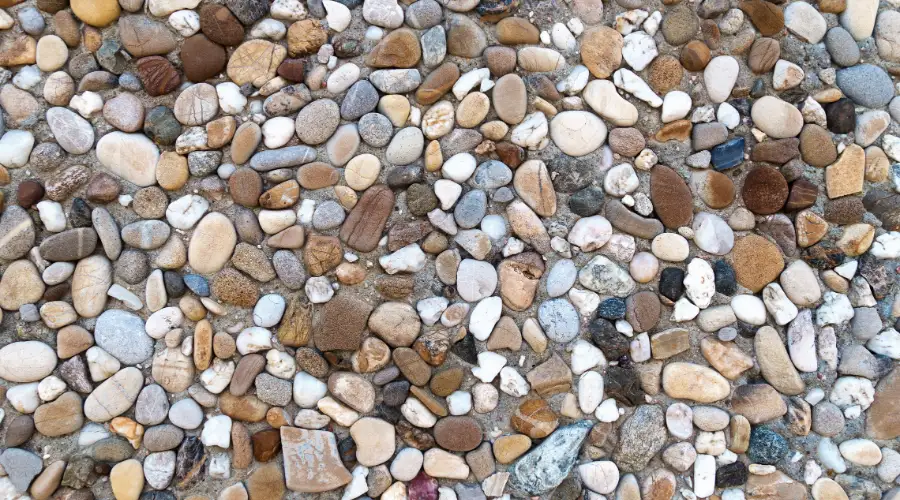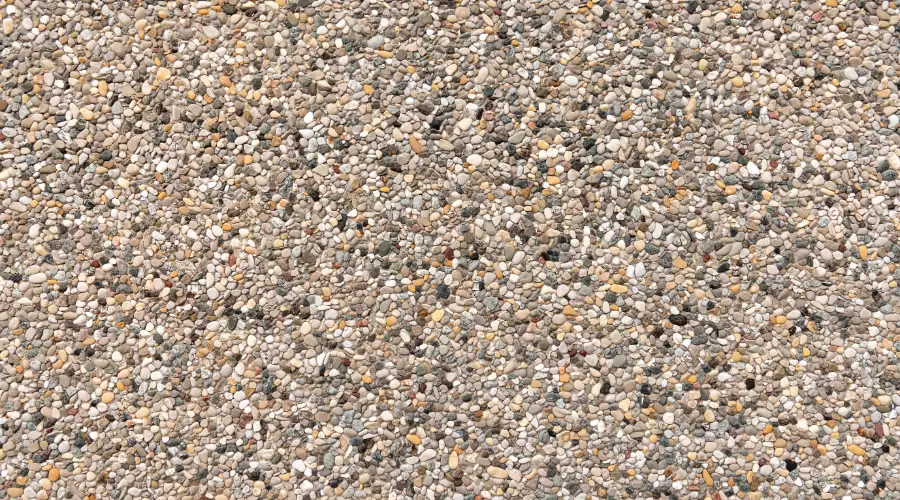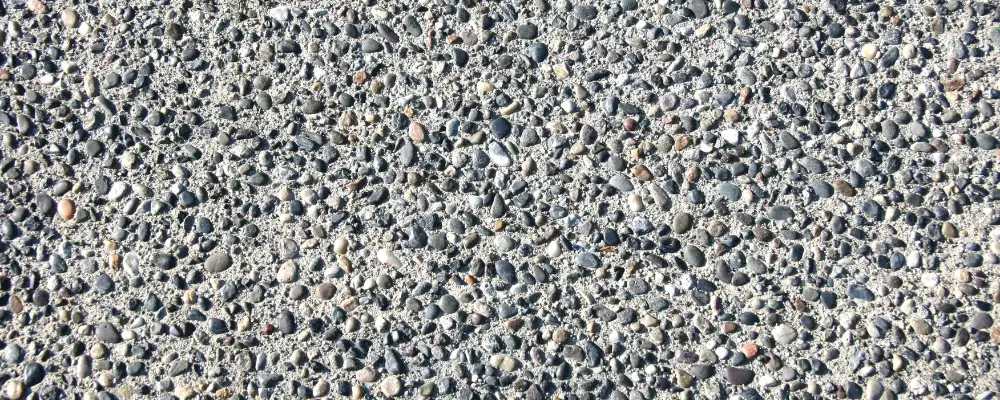The growing appeal of exposed aggregate flooring in civil and architectural applications stems from its sleek appearance and dependable performance. Exposed aggregate flooring is a uniquely decorative finish that features artistically exposed aggregates located in the concrete mix. It has a beautiful combination of appearance, durability, and functional service. Its wide range of applications across residential, commercial, and public works projects highlights its versatility, effectiveness, and long-term value. Keep reading to discover everything you need to know about exposed aggregate concrete in detail.
What is Exposed Aggregate Concrete?

Exposed aggregate concrete is a decorative finish in which the surface cement paste on the upper portion of the concrete surface is removed to create an exposed fine aggregate surface that showcases the natural aggregates (gravel, crushed stone, decorative stone, etc.) to give the concrete surface a textured and decorative appearance.
The exposed aggregate finish can be obtained by
- Washing or brushing the surface mortar before it fully sets, or by abrasive blasting after curing.
- Using a chemical retarder on the upper surface of the concrete to protect the lower layer until the surface layer has cured sufficiently to be removed.
It highlights the desired characteristics of the selected aggregates to provide texture and aesthetics.
Exposed aggregate concrete is very flexible in terms of design options; it allows you to customize the final finish by selecting the aggregate type, size, colour, and placement of the coarse aggregates as necessary for the construction’s architectural needs. Its versatility, combined with durability and slip resistance, has made it an increasingly popular choice across a wide range of construction projects, from residential spaces to commercial and public works.
Pros and Cons of Using Exposed Aggregate Concrete
Pros
- Aesthetic Flexibility: Decorative exposed aggregate concrete has a wide range of aesthetic options based on the type, color and size of aggregate and can be used in almost any landscaping or architectural style.
- High Durability: Decorative exposed aggregate concrete is highly resistant to wear, freeze–thaw damage, and heavy loads, making it appropriate for heavy traffic and outdoor uses.
- Slip Resistance: The rough, textured surface of exposed aggregate decorative concrete delivers strong slip resistance, making it safer under wet conditions by minimizing the risk of falls.
- Low Lifecycle Cost: With very little maintenance and a long service life, costs will be saved over time.
- Environmental Flexibility: Exposed aggregate concrete could be designed using either locally sourced or recycled irregular aggregate, giving an opportunity for sustainable construction
Cons
- Roughness: The rough surface is inappropriate for bare-footed use, especially in poolside and recreation applications.
- Repair Constraints: Repairing or patching exposed aggregate surfaces is challenging because it is difficult to replicate a uniform look. In order to match the existing materials, one needs to match the type, color, texture, size, and distribution of the aggregate as closely as possible, which can take time.
- Installation Timing: Using exposed aggregate also requires skilled tradespeople and timing during the exposure process. If timing is improperly managed, the surface may not be as uniform, or aggregate may become loose, such as in high-traffic areas.
- Aggregate Degradation: If sealing is inadequate or not done properly, or as a result of poor installation, the surrounding cement paste can erode, causing aggregates to loosen over time, which can reduce the performance of exposed aggregate.
- Initial Cost: The initial installation may be more costly, as it may be necessary to pay higher prices for labor and more expensive materials, but over its useful life, the ownership cost of exposed aggregate will be less than that of plain concrete.
Application of Exposed Aggregate Concrete

Exposed aggregate concrete is a popular material choice for a wide range of construction and landscaping projects due to its durability, aesthetic appeal, and slip-resistant surface.
- Driveways and Walkways: Ideal for paths for vehicles and pedestrians due to their strength and ability to prevent slips.
- Patios and Pool Decks: Will beautify outdoor living areas and create a safer area for recreation.
- Urban Plazas and Public Spaces: A strong and visually appealing choice for civic infrastructure that can withstand heavy pedestrian traffic.
- Staircases and Ramps: Create essential additional grip, improved user experience, accessibility and safety.
- Retaining Walls and Architectural Features: Although used in vertical surfaces, these can add visual interest as a decorative value in landscape features and structures.
- Industrial Flooring: Suitable for heavy-duty, non-slip surfaces in service areas such as loading docks, warehouses, and maintenance yards where safety is a priority.
Methods to Create Exposed Aggregate Concrete
There are a number of methods to create exposed aggregate finishes, all of which vary visually and functionally.
- Monolithic Exposed Aggregate: The aggregates are mixed into the concrete before placing and then are exposed once the concrete hardens. This method ensures proper distribution of aggregates throughout the slab.
- Seeded Aggregate: Decorative aggregates are applied to a freshly poured concrete surface and embedded by using rollers or trowels. Manual placement of the aggregates allows for specific types and proper distributions of normal aggregates.
- Overlay Exposed Aggregate: A thin layer (overlay) of concrete containing selected decorative aggregates is applied over an existing surface. This is often used to rejuvenate old or worn concrete economically.
- Polished Exposed Aggregate: Once the concrete is exposed, the surface can be mechanically polished to create a smooth/slick surface while keeping the aggregate exposed. This is often used for high-end architectural projects.
- Stenciled or Patterned Exposed Aggregate: Exposed aggregate techniques are combined with stenciling or patterning to produce decorative designs, logos, or custom motifs, enhancing visual appeal for special projects.
How to Prepare Exposed Aggregate Concrete
Exposed aggregate concrete has many critical stages of techniques and methods to follow for optimal performance and aesthetics. The critical stages of exposed aggregate processes include:
- Substrate preparation: Excavate the subgrade and compact the underlying material, install any formwork, and make sure that drainage is prepared to minimize any accumulation of water.
- Mix design: Choose aggregates that are high quality (conforming to IS 383:2016 or ASTM C33) and establish a concrete mix design that will achieve the intended workability, strength, and aggregate exposure.
- Placement: Pour the concrete and spread it evenly, and incorporate the aggregates throughout the slab or uniformly if doing a seeded application.
- Leveling and floating: Once placed, screed the surface to your desired level and cross-float with a bull float to embed aggregates within the top layer of the slab.
- Surface retarder application: Use a chemical surface retarder on the top layer to delay hardening and create a controlled option to remove excess cement paste.
- Exposure process: At the optimal waiting time (generally 4–24 hours), use water and a stiff brush or pressure washer to scrub the surface mortar off. Timing is critical during this step to avoid too much loss of aggregate or an incomplete exposure of aggregates.
- Curing: Ensure sufficient hydration and temperature for proper curing according to either IS 456:2000 or ACI 308R.
- Sealing: Use a high-performance sealer on the surface to improve colour, durability, resistance to staining, and freeze-thaw considerations.
Main Factors to Consider When Selecting Aggregate
Selecting the best aggregate for exposed aggregate concrete is important for the exposed aggregate concrete’s performance. The aggregate selected should take into consideration the following:
- Size & Gradation of Aggregate: The aggregate size ranges from 6 mm to 20 mm, usually, but to ensure even exposure and maintain structural integrity where exposed, even graded aggregate is desirable.
- Shape & Texture: Rounded aggregates create a smoother, more decorative surface that is comfortable underfoot. Angular aggregates improve slip resistance but give a more rugged texture.
- Color: Natural stone, recycled glass or manufactured aggregates have multiple color and finish options to accommodate use and blend with their respective surrounding environments.
- Hardness & Durability: Aggregates must be adequately hard to resist the effects of environmental exposure and mechanical wear, resist abrasion, and be chemically stable in the environment they will be exposed to.
- Cleanliness: The aggregates must be free of any dust, clay, and organic materials and contaminants that could adversely impact whether it is a bonding and/or appearance problem to the surface.
- Local Availability & Sustainability: It is always best to select recycled aggregates or aggregates that are in close proximity to a project to minimize transportation costs and the environmental footprint associated with that transportation.
Maintenance of Exposed Aggregate Concrete
Regular maintenance is important for maintaining the physical and aesthetic performance of exposed aggregate surfaces.
- Cleaning: It is recommended to sweep your surface regularly and remove any debris to prevent staining. You can use a mild detergent and low-pressure water for any stubborn stains.
- Applying Sealers: You should apply your preferred compatible sealer every 2 to 3 years (or as per the manufacturer’s recommendations). This will ensure that your surface is protected and the aggregates are retained within the matrix.
- Repair Cracks and Joints: Regularly inspect your surface for cracks and joint separation. If necessary, repair them promptly with suitable patching compounds to prevent water ingress and freeze-thaw damage.
- Avoid Hard Deicing Chemicals: You should have a limited use of hard deicing chemicals, as these will damage the sealer as well as the concrete matrix.
- Professional Inspection: Having qualified professionals conduct inspections from time to time can help identify any early signs of wear or damage to the surface, thus enabling you to react in a timely manner.
Conclusion
Exposed aggregate concrete is a versatile construction choice that combines structural strength with a wide range of aesthetic possibilities. By carefully selecting materials, planning installation methods, and prioritizing sustainable practices, designers and builders can create durable, low-maintenance, and visually appealing surfaces. When executed thoughtfully, exposed aggregate concrete offers both long-term value and timeless visual appeal.
Frequently Asked Questions (FAQ)
A typical thickness ranges from 100 mm (4 inches) for pedestrian areas to 150 mm (6 inches) or more for driveways and heavy-duty applications.
Yes, required colour pigments can be added to the concrete mix, and colored aggregates can be used to achieve a wide variety of hues and effects.
Exposed aggregate concrete reveals the natural texture of aggregates, while stamped concrete uses molds to imprint patterns on the surface.
When using locally sourced, recycled, or sustainable aggregates, exposed aggregate concrete can contribute to green building certifications and reduce environmental impact.
Aggregate loss is typically due to inadequate sealer application, poor installation practices, or excessive surface wear from heavy traffic or harsh cleaning.
Depending on project size and complexity, installation—including curing and sealing—can take from several days to two weeks.

